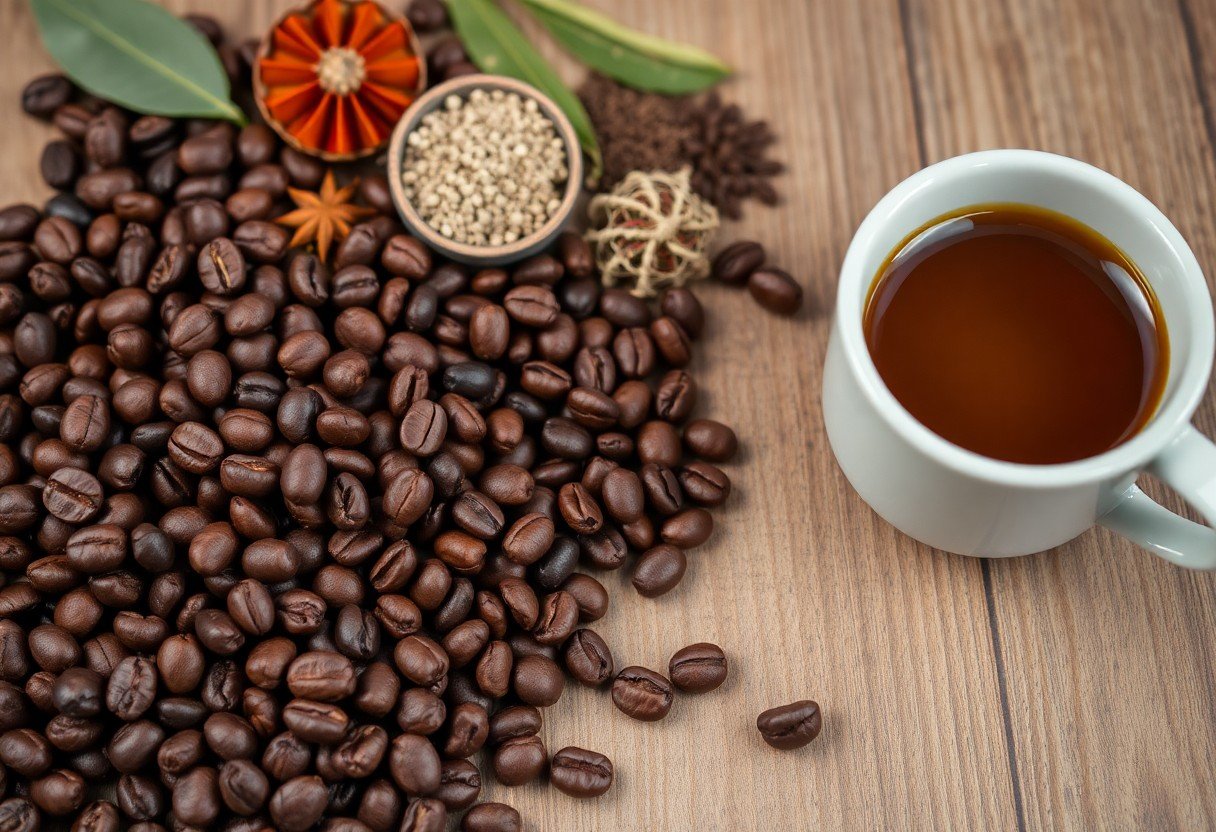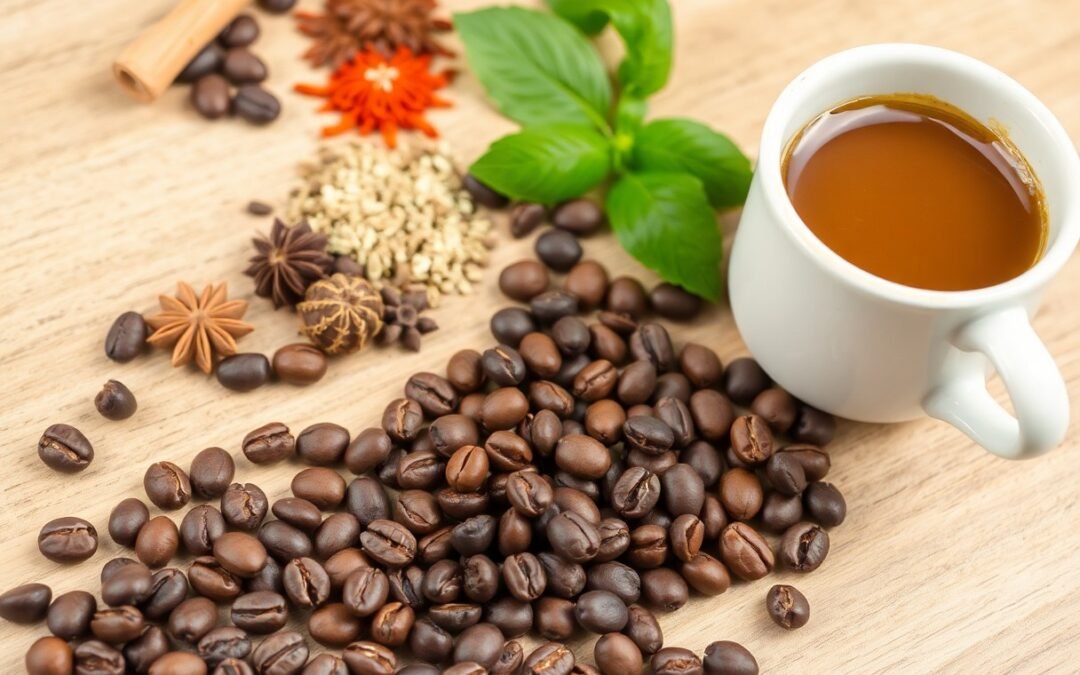Just imagine the rich tapestry of flavors that emerge when you roast your coffee beans at home. To truly uncover the subtle nuances in self-roasted beans, you must engage deeply with your roasting process, from choosing the right green beans to mastering the art of timing and temperature. Understanding what specific flavors or characteristics are you seeking in your coffee will guide your exploration. This journey not only enhances your tasting experience but also allows you to develop a personal connection with your brew.

Understanding Flavor Profile
For anyone seeking to deepen their coffee experience, understanding the flavor profile is necessary. Each coffee bean has unique characteristics influenced by its origin, processing method, and roast level. By exploring these elements, you can learn to identify various tasting notes, from fruity to nutty or chocolatey, and appreciate the complexities that come from self-roasting your beans.
The Basics of Coffee Taste
Profile your palate by recognizing the fundamental aspects of coffee taste, which include acidity, sweetness, body, and aftertaste. Each of these elements plays a role in how you perceive flavor and can significantly enhance your coffee enjoyment. By developing a vocabulary around these tastes, you’ll be better equipped to describe your findings and preferences.
The Impact of Roast Levels
About the roast level, it influences the flavors present in your coffee significantly. Lighter roasts tend to preserve the beans’ original characteristics, offering bright acidity and fruity notes, while darker roasts bring out deeper, more robust flavors, often with chocolatey or smoky undertones. Your choice of roast level ultimately affects the overall tasting experience.
It’s important to experiment with different roast levels to discover how they impact flavor. A lighter roast can reveal vibrant, floral notes, allowing you to appreciate the bean’s origin. In contrast, a medium roast strikes a balance between acidity and sweetness, providing a well-rounded cup. Dark roasts, while bold and intense, may overshadow the subtler nuances of the coffee. By adjusting your roasting techniques, you can tailor the flavor profile to match your personal taste preferences.
Selecting Coffee Beans
Even the best brewing techniques cannot fully mask the importance of selecting high-quality coffee beans. Take the time to research and source beans that meet your specific taste preferences. Look for importers and local roasters that prioritize ethical sourcing and freshness, as these factors can greatly influence the flavor and aroma of your self-roasted coffee.
Choosing Origins and Varieties
About the origins and varieties of coffee beans, it’s necessary to understand that each region offers unique flavor profiles. Beans from Ethiopia, for example, tend to exhibit fruity and floral notes, while those from Brazil are often nutty and chocolatey. Explore different varieties and blend them to discover a personalized taste that resonates with your palate.
The Role of Freshness
For the best flavor experience, focus on the freshness of your coffee beans. Freshly roasted beans release carbon dioxide, which can significantly impact your brew’s overall taste. Always aim to roast and consume your beans within a few weeks for optimal flavor.
Plus, the freshness of your coffee beans doesn’t just enhance their flavor; it also affects the aroma and overall coffee experience. As beans age, they lose necessary oils, leading to flat and dull flavors. When you source your beans, check their roast date and try using them within two weeks of roasting to get the most vibrant taste possible. Investing in a dedicated storage container can further help maintain freshness and protect your beans from light, air, and moisture, ensuring your self-roasted coffee burst with flavor every time.
The Roasting Process
You commence on an adventurous journey when you probe into the roasting process of coffee beans. Each stage of roasting impacts the flavors, aromas, and acidity of your brew. As the beans transform from green to brown, you’ll witness a symphony of chemical reactions that unlock complex flavors, making it vital to monitor this transformative journey meticulously. Understanding the stages of roasting will allow you to highlight and cultivate the subtle nuances of flavor in your self-roasted beans.
Equipment and Techniques
At the heart of your roasting adventure lies the choice of equipment and techniques. Whether you opt for a dedicated coffee roaster, a stovetop popper, or an oven, each method will yield distinct results. Techniques such as controlling heat application, stirring, and timing will allow you to navigate your roast effectively. Familiarizing yourself with your chosen equipment ensures you produce consistent batches while exploring new flavor profiles.
Achieving Desired Roast Levels
The journey to achieving your ideal roast level involves much more than simply knowing desired outcomes; it requires a keen sense of timing and attention to detail. A light roast brings out the inherent characteristics of the beans, while a darker roast shifts the focus towards a bolder flavor profile. As you learn to judge the color and aroma during roasting, tuning in to the crack sounds emitted by the beans will also signal when to adjust your heat and time.
Another approach to enhancing your roast precision is to keep a detailed log of each roast, noting variables such as time, temperature, and bean origin. This data can guide you in replicating or adjusting roasts to achieve desired flavor outputs. Taste testing each batch will provide invaluable insight, helping you understand how subtle changes influence the final cup. Embrace the nuance and experimentation, as they will ultimately refine your roasting skills.
Post-Roasting Considerations
Once again, the journey of flavor exploration doesn’t end with roasting. After you’ve achieved that perfect roast, the way you handle your beans post-roast can significantly impact the final taste of your brew. Factors like cooling, storage, and grinding are vital, as they influence flavor retention and freshness, allowing you to enjoy the unique profile of your self-roasted beans fully.
Cooling and Storage
An important step after roasting is to cool your beans quickly to halt the roasting process. Leaving them in a hot environment can lead to unwanted flavor changes. Once cooled, store your beans in an airtight container, away from light and moisture, to preserve their delicious profile.
Grinding for Optimal Flavor
Below, you’ll discover how the grind size of your coffee beans affects extraction and overall flavor. Different brewing methods require varying grind sizes, so adjusting this can enhance your coffee experience significantly.
It’s important to consider that the grind size directly influences how quickly water extracts flavors from the coffee during brewing. A finer grind typically leads to a more intense flavor but can also result in over-extraction, causing bitterness. Conversely, a coarser grind may produce a milder, lighter taste. Experimenting with different grind sizes tailored to your chosen brewing method can unlock the subtle nuances in flavor, helping you find the perfect balance that suits your palate.
Brewing Methods
Keep in mind that your brewing method significantly influences the subtle nuances of flavor in your self-roasted beans. Whether you prefer French press, pour-over, or espresso, the technique you choose can highlight different aspects of your coffee. Delve deeper into Exploring The Flavor Profiles of Light, Medium, and Dark … to enhance your tasting experience.
Various Brewing Techniques
Any brewing technique you select can alter the final flavor profile of your coffee. From immersion methods that allow full saturation to drip techniques that extract flavors more slowly, each approach showcases distinct characteristics of your roast.
The Influence of Water Temperature
Around 90-96°C (195-205°F) is the ideal water temperature range for brewing coffee, ensuring proper extraction of flavors without burning your beans. Different brewing methods may require slight adjustments in temperature to achieve optimal taste.
| Method | Ideal Temperature (°C) |
| French Press | 92-96 |
| Pour-Over | 90-93 |
| Espresso | 90-95 |
And, understanding that various temperatures can enhance or mute certain flavors is necessary for refining your brewing process. Adjusting your water temperature to match the beans can elevate your coffee experience significantly, allowing you to explore a broader range of flavor profiles. Different beans and roast levels may require fine-tuning to find the perfect temperature for optimal extraction.
| Temperature (°C) | Flavor Characteristics |
| Below 90 | Under-extraction, sour notes |
| 90-96 | Balanced extraction, sweet and complex |
| Above 96 | Over-extraction, bitter flavors |
Tasting and Evaluating
Now that you’ve self-roasted your beans, it’s time to look into the tasting and evaluating process. Utilize a systematic approach to appreciate the full spectrum of flavors in your cup. Begin by savoring the aroma, then take small sips, allowing the coffee to move across your palate. Pay attention to body, acidity, and finish. Taking notes during this process will help refine your tasting skills and deepen your connection with the flavors you discover.
Developing Palate Sensitivity
On your journey to becoming a coffee connoisseur, developing palate sensitivity is key. Engage in tasting sessions where you experiment with various coffee types and brewing methods. The more you expose your palate to different flavor profiles, the more adept you will become at identifying distinct notes in your self-roasted beans.
Noting Subtle Flavor Nuances
Nuances play a significant role in tasting coffee, as they can reveal complex flavors that enhance your experience. Take time to focus on these faint qualities, such as hints of chocolate or fruity undertones. A discerning palate allows you to appreciate the skill involved in roasting and the individuality of each bean.
It’s vital to be observant and patient when identifying these subtle flavor nuances. Use a flavor wheel or guide to assist in categorizing what you taste, as this will help you articulate your impressions more effectively. By actively seeking out these nuances, you enrich your coffee appreciation and uncover the unique characteristics of each batch you roast.
1. Roast beans in small batches for precise flavor control.
2. Vary roast time to highlight different flavor notes.
3. Use a consistent heat source to ensure even roasting.
4. Record roast profiles to compare subtle taste differences.
5. Smell beans at different stages for aroma clues.
6. Brew samples immediately to evaluate fresh roast flavors.
Summing up
Conclusively, to explore the subtle nuances of flavor in your self-roasted beans, you should focus on several key factors: select high-quality green beans, master your roasting technique, and experiment with various roast levels. Pay close attention to the aroma and taste through each stage of roasting, and keep detailed notes to refine your process. Additionally, consider your brewing method and water quality, as these also influence flavor extraction. Engaging in this mindful exploration will enhance your coffee experience, allowing you to appreciate the intricate profiles unique to your home-roasted beans.

